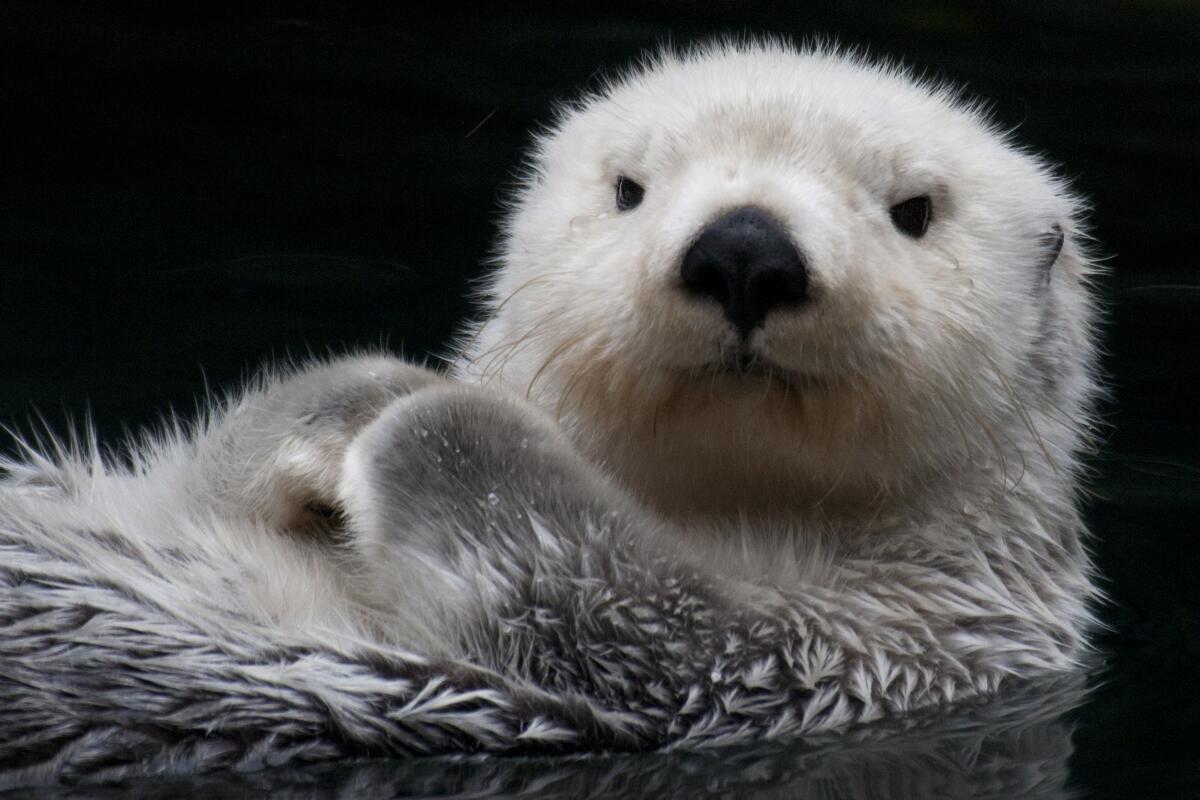Op-Ed: Send in the sea otters to help save California’s North Coast

- Share via
Kelp forests are a crucial California marine ecosystem. From kelp’s floating canopies to its “holdfast” roots, the giant seaweed — algae, actually — supports greater biodiversity and sequesters more carbon than a redwood grove, while also protecting our coastline from the full force of Pacific storms. Kelp forests shelter fin fish, shellfish, whales, seals, octopuses and sharks — more than 1,000 animal and plant species in all.
Unfortunately, since 2013 the state’s kelp beds have been in an unprecedented state of collapse. From San Diego to Monterey the losses are patchy, but north of the Golden Gate more than 95% of the kelp is now gone. Warming oceans combined with past hunting and fishing practices upset the balance between predators and prey in the kelp forest, with devastating effects.
One possible remedy has a satisfying twist — return the sea otter, the keystone kelp forest predator, to its historical range along the North Coast.
Perhaps 300,000 sea otters once thrived along the north Pacific Rim, from Japan to Baja, until humans hunted them almost to extinction in the 19th century. They’ve rebounded since they were fully protected in the U.S. 50 years ago, and in California they’ve recolonized about 13% of their range, especially in and around Monterey Bay.
Why not farther north? Possibly because they can’t make it past a burgeoning white shark population. If humans help them make the leap, they might be able to protect surviving North Coast kelp beds, and kick-start a more complete restoration.
California’s kelp catastrophe has two immediate causes. In 2013, a marine heat wave that scientists dubbed “the blob” caused ocean temperatures to spike along the West Coast, weakening the kelp, which thrives in cold, nutrient-rich currents. Then a virus — probably supercharged by the warmer waters, according to a 2019 study — allowed purple urchins, voracious kelp eaters, to proliferate.
The virus, known as the sea star wasting syndrome, is on a par with horror movie scourges. It melts the limbs and bodies of what we used to call starfish, including the many-armed sunflower sea star, a purple urchin predator. On the North Coast, with sea otters long gone, sunflower sea stars have been the major purple urchin predator. (Another top urchin predator, commercial fishermen, targets larger, meatier species.)
Since the sea star die-off, the quarter-sized purple urchins have run amok, especially off the Sonoma and Mendocino coast, devouring kelp and replacing the complex near-shore kelp forest habitat with “urchin barrens” — a seabed carpeted with pastel pin cushions.
To combat the devastation, divers — some volunteers and some paid by the state and private donors — have organized efforts to suction up, collect or take hammers to the urchins by the tens of thousands. But there’s no indication it’s helping much. Even as the kelp starts to recover, hungry purple urchins find it and the destruction begins all over again.
Sea otters are nearly as insatiable as purple urchins. They lack the blubber common to other marine mammals and depend for warmth on their luxuriant fur (the prize that led to their slaughter in the 1800s). They run hot; their metabolism requires that they eat up to a quarter of their body weight each day in abalone, crab, octopus — and urchins.
Letting otters expand their range on their own is ideal, but relocating them is possible. It could start with 10 or 12 — a sea otter SWAT team — from what’s estimated to be a California population of about 3,000. In fact, U.S. Fish and Wildlife has years of experience relocating the marine mammals with varying success, often at the behest of the fishing industry, which tends to view otters as competition.
North Coast fishermen, too, may not welcome back otters. On the other hand a lot of science — and in-the-water evidence at the Channel Islands and other MPAs (marine protected areas) — indicates that the more intact the near-shore ecosystem, with a healthy mix of predators and prey, the better the fishing will be in adjacent waters.
It was a remnant population of sea otters from Big Sur that recolonized Monterey Bay. Their presence played a key role in restoring the area’s kelp forests after the closure of Monterey’s polluting canneries. Today the bay and the city are a world center of marine biodiversity, with a thriving economy based on tourism (starring sea otters), marine science and fishing.
Otters could help in the battle to save North Coast kelp, but they aren’t a silver-bullet solution. That’s because the urchin barrens are in part populated by “zombies.” Once purple urchins destroy too much kelp, they turn auto-cannibalistic rather than starve to death; they feed on themselves. Otters aren’t much interested in the shell-like results. Studies in Monterey Bay show that even though otters don’t clear the barrens, they keep proliferating purple urchins in check wherever kelp survives.
Kelp forests are good at reproducing themselves; one hope is that the balance the otters maintain would allow kelp to reseed whenever and wherever a storm or some other natural event — or human effort — scrapes away enough zombies.
Conservationist Aldo Leopold once wrote, “To keep every cog and wheel is the first precaution of the intelligent tinkerer.”
On the North Coast, the way back to a healthy ocean will take planning, funding and cooperation and some intelligent tinkering. Reestablishing sea otters throughout their traditional range could be a start.
David Helvarg is the executive director of Blue Frontier, an ocean conservation and policy group. His latest book is “The Golden Shore — California’s Love Affair with the Sea.”
More to Read
A cure for the common opinion
Get thought-provoking perspectives with our weekly newsletter.
You may occasionally receive promotional content from the Los Angeles Times.










